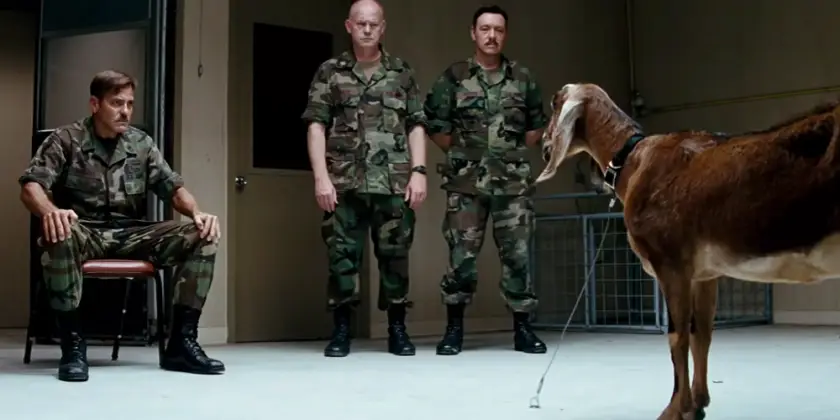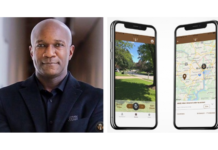
On the morning of May 15, 1987, Paul H. Smith, a robust thirty-four year old captain in the U.S. Army’s Psychic Espionage Unit, Center Lane (later known as Stargate), lay down in an all-gray room in Fort Meade, Maryland, and relaxed his mind by listening to music. Twenty minutes later, in a different gray room, he listened as his colleague, Ed Dames, recited a series of random numbers that represented a military target. Within minutes, he was no longer seeing the walls or the table or Dames. He was now somewhere else.
“I perceived a large metal object, like a warship at night in a large body of water,” he says. “I saw an aircraft that dropped a metal object that started flying. I heard noises like clanging sounds and people screaming, and I saw smoke and fire and water. It was very chaotic.”
For about an hour, Smith drifted in a reality that was beyond normal comprehension, seeing flashes of images, hearing snippets of sounds and feeling the terror of an event that he couldn’t fully grasp. As protocol dictated, he jotted down words associated with what he was seeing — “water,” “vessel,” “smoke” and “wings” — and then tried to sketch an image from those words and sensations. Unsatisfied and somewhat confused by what Smith was perceiving, Dames ended the session.
“You’re off today,” Dames told him, and they both went home for the weekend.
That Monday morning, headlines across the country announced that an Iraqi fighter-bomber had fired two anti-ship missiles at the USS Stark, a frigate patrolling the Persian Gulf. The missiles had ripped a hole in the port side of the ship, killing thirty-seven sailors and injuring twenty-one. The ship’s radar had failed to pick up the missiles. Smith, in a gray room thousands of miles away, had not.
Now sixty-one and long-retired from the Army, Smith is a tall, burly man with an engaging and deeply pensive demeanor that makes him seem more like a nineteenth-century philosopher than a career military man. But at his core, he is a storyteller, and the Stark is one of his favorites.
“I saw something that hadn’t happened yet,” he says. “I had never done that with such detail and precision, and it proved to me that we could see into the future, that the mind could transcend the body and see things.”
That event, along with the revelatory tenets of his Mormon faith, inspired much of his post-military life. As the president of his own company, Remote Viewing Instructional Services, Smith now devotes himself to enhancing in others the power that he believes he has within himself. “I believe that people have this [psychic] power to access information that is somewhere else,” he says. “Everyone can do this. It’s just tapping into the fundamental basis of reality.”
Growing up twenty miles from the glittering Las Vegas strip, in the quaint and historic desert city of Boulder City, Nevada, Smith spent much of his youth absorbed in fantasy. When he wasn’t outside playing Army games, he could be found drawing detailed pictures of tanks, planes and warships or being swept up into the alternate universes created by the great sci-fi writers: Heinlein, Asimov and, one of his favorites, Andre Norton. Brimming with highly intelligent, exotic fictional animals that formed telepathic links with humans, Norton’s worlds in particular held him rapt, piquing his curiosity in different forms of communication.
As Smith began to shed the skin of boyhood, his interest in the military became more sophisticated, and in the late 1960s, a series of significant events unfolded that left deep and lasting impressions on him: Vietnam; the Six-Day War between Israel and the Arab States, which began his preoccupation with the Middle East; and the rise of James Bond, who seduced him with his big-screen melding of espionage and romance. From all standpoints, it seemed certain that Smith would enter the military and devote himself to the service of his country. But by the time he graduated high school, his interest in a military career had waned. “I didn’t want anyone telling me what to do,” he says. In his junior year of college, something would change that. Her name was Betti.
Betti happened quickly and unexpectedly. Within hours of meeting her, Smith was sitting behind the wheel of her father’s old pickup, driving them both through the scenic back roads that stretched between Utah and Las Vegas. “She needed to get her things back from college,” Smith recalls, “and the truck was a stick shift. She couldn’t drive stick. I needed a ride, and she needed a driver. It was perfect, until the fuel filter clogged, and I could only do thirty miles per hour. Suddenly, an eight-hour trip turned into a twenty-four-hour ordeal. By the time I dropped her off at her parents, I was interested in her.”
Two years later, Smith and Betti were married, poor and living in Provo, Utah, where Smith had a bachelors degree in art but didn’t have a job. “She began pushing me to join the Army to support our family, but I had no interest,” he says. She persisted, and in June 1976, at a recruiting facility in Salt Lake City, Paul Smith officially became Private Paul Smith.
Surprisingly, Smith took to the Army, and after boot camp he went to the Presidio of Monterey, a military installation in California, to learn Arabic. After spending a year conjugating verbs by the rugged Pacific coastline, Smith was excited to have his first permanent position in Fort Campbell, Kentucky. But his excitement quickly dissipated. “The problem with the Army is that you don’t really do your job,” he says. “I was spending a lot of time washing Jeeps and fixing generators instead of using my new language skills.”
He grew bored.
Six months later, Smith enrolled in Officer Candidate School, leading to a military intelligence post in the foothills of the Bavarian Alps. After “an idyllic three years” in Germany, Smith accepted a position as a Middle East desk officer at Fort Meade. He was there just three months before he was asked the question that would change his life: “Do you want to be a psychic spy?”
Eleven years earlier, in 1972, a small group of intrepid individuals were experimenting with the possibility of harnessing psychic power for the U.S. intelligence community. At the center of this early research was Uri Geller, a handsome, Israeli-born magician, psychic and self-proclaimed “space prophet” who became famous for bending thousands of spoons with his mind.

Geller, allegedly a distant descendant of Freud, burst onto the world stage in 1970 with his powers of psychokinesis and telepathy. In just two short years, Geller’s universe went from showcasing his spoon-bending skills to becoming a modern-day Elijah, commissioned by the Mossad and Shin Bet, Israel’s CIA and FBI equivalents, to do clandestine work that included everything from mentally erasing the contents of floppy disks carried by KGB agents to disabling radar stations and Syrian nuclear reactors.
It was not long before the Soviets became interested in Geller, and Soviet interest meant American interest. The Russians had been using psychics for some time, and American fears of super-powerful Russian mentalists soon paved the way for a psychic arms race that, for the next 15 years, would be played out in the labs and painted gray rooms of Stanford Research Institute (SRI), now SRI International, in Menlo Park, California.
Known for sponsoring research on off-the-beaten-path projects, SRI was more than happy to house the physicists and parapsychologists Harold Puthoff and Russell Targ, who were attempting to scientifically quantify psychic abilities for the U.S. Intelligence community. When the two scientists learned of Geller, they invited him to the institute to participate in a series of experiments designed to authenticate his purported psychic abilities.
According to an interview with Targ, Geller never actually succeeded in bending anything at SRI; instead, he did something more remarkable: He “described hidden pictures”— essentially, Geller telepathically described images sealed in envelopes, hidden in other rooms, in other buildings and even in other states.
Targ and Puthoff were euphoric.
At the same time that Geller was confounding the scientists, Ingo Swann, a New York-based artist and self-defined psychic, was also at SRI undergoing similar tests to validate his psychic claims. Unfortunately, Swann’s results were paltry compared to Geller’s, leaving the scientists uninspired. Frustrated, Swann blamed his poor performance on the lack of method in testing psychic ability. “Back then, there was no method on how to do it. The ‘viewer’ was just asked to describe a random image that was hidden somewhere, and if he succeeded, great,” Smith explains. “If he didn’t, he didn’t.”
Aware that the CIA was interested in using psychics for spying, Swann knew that finding a consistent and fixed method, which would direct the viewer’s mind to a specific target, was critical. One night while enjoying a poolside Scotch, Swann claims he heard a voice tell him to “try coordinates.” He did, and with that the golden age of psychic spydom and Coordinate Remote Viewing (CRV) was born.
Swann’s timing was impeccable. Giving viewers specific coordinates (longitude and latitude) introduced a more cohesive and controlled way of directing their mind to the target, and it allowed experiments to be measured and replicated. All this added a much-needed air of seriousness to a field that some derided as an amusement park sideshow.
In June of 1973, as Geller was on his way out and as Swann continued to develop and refine CRV, Puthoff, now deep in his research, received a call that would change everything. The caller was a retired police commissioner, Alaskan gold-panner, building contractor and Christmas tree salesman. He believed that alien bases were lodged in the oceans and mountains, that he could evaporate clouds and change traffic lights, and he claimed to have the “gifts” of telepathy and psychokinesis. His name was Pat Price, and he was interested in becoming a research subject. Despite his outlandish beliefs, Price seemed to be a bona fide psychic. From the outset he reportedly viewed a number of significant military targets with ease, the most renown being the nuclear testing facility Semipalatinsk in Kazakhstan. Suspecting some kind of nuclear activity, the CIA sponsor of the CRV program asked Price to remote view the location. Given the coordinates, Price leaned back in his chair and slipped into his psychic reverie:
“I am lying on my back on the roof of a two- or three-story brick building. There’s a giant gantry crane moving back and forth over my head. As I drift up in the air and look down it seems to be riding on a track with one rail on each side of the building.”
Over the next few weeks, Price “returned” to Semipalatinsk, filling in more details about the site: The crane was moving large objects; in another room, people were working on the assembly of a giant “sixty-foot-diameter metal sphere…assembled from thick metal gores, and there was a cluster of tall compressed-gas canisters.” From Price’s accounts, it seemed something unknown and possibly sinister was taking place there.
The CIA was impressed by the gantry-crane drawing and confirmed that Price’s sketch was eerily similar to satellite images taken of the crane at the actual facility. The rest of the information they couldn’t verify. Years later, further satellite images would actually corroborate that Price’s viewing was indeed the infamous Semipalatinsk nuclear facility where the Russians detonated at least 456 nuclear devices over forty years.
Price continued to impress the scientists and intelligence agencies by roaming through countries on psychic jaunts, unveiling everything from a school of Russian submarines moving through the Pacific to a device that would supposedly make President Nixon suffer. But, despite his success and others who followed, it would be another four years until the Army established its first official remote viewing program.
In May 1983, Smith and his family arrived in Fort Meade and moved into a two-story brick townhouse on a tree-lined street in the neighborhood of Geraghty Village. The pretty row houses, with neatly manicured lawns filled with children playing and dogs barking, made it nearly impossible to avoid becoming part of the tight-knit military community. But it wasn’t long before Smith sensed something was amiss with his two neighbors, captains Fred Atwater and Tom McNear, who were never in uniform.
His suspicions were right. Atwater and McNear were part of a highly classified secret project, and according to Smith, the pair had been watching him for some time. Creative, intelligent, multilingual and accomplished, they felt Smith was a good candidate for the project. “We’d like you to take some tests,” McNear said. “If you score in the general area, then we will bring you on.”
After undergoing a battery of psychological exams and questionnaires, Smith was deemed fit for the project, and he made his way to Fort Meade’s WWII training battalion cantonment area. Passing the abandoned administration buildings and windowless barracks, Smith arrived at the former mess hall. He knocked on the door.
What followed was, as Smith describes it, “my ‘Men in Black’ moment.”
In a back room of the former mess hall, over a long, worn wooden table, McNear presented Smith with the strictest non-disclosure statement he had ever seen. Smith signed it, and McNear explained the project:
“What we do here is collect intelligence against foreign threats using a parapsychological field called remote viewing. Doing it could affect your career, change your outlook on life and have an impact on your personality. You won’t be able to tell anyone that you are in the Army and you can never discuss what you do. We want you to become a psychic spy. You have twenty-four hours to think about it.”
“I don’t need to think about it,” Smith said. He went home, hung up his uniform and told his wife he had a new position.
In those early days, Smith read a lot, watched other people and eventually began engaging in his own ad hoc sessions, some of which set off cultural and religious anxieties. “At first, it was all a little spooky,” he says, “because I was dealing with the unknown, and sometimes I couldn’t help but think superstitiously. What if this is the power of the Devil? What if this wasn’t real? It was certainly strange and unique, and I had a strange feeling; not a bad one, but a weird one. I can’t explain it.”
Four months later, in January 1984, most of his fears were put to rest when Smith and three of his colleagues went to SRI to learn remote viewing from Swann, who Smith describes as a “ruthless, tough and demanding” taskmaster. By this time, Swann’s original system of giving simple geographic coordinates had, with Puthoff’s help, evolved into an elaborate methodology based on a deep metaphysical theory of human perception and the ability to see beyond what is visible.
After years of research, Swann and Puthoff had determined that people could see into the past and the present, suggesting to them that there was some kind of repository outside our time-space continuum that held information about everything and anything. Swann called this repository the “Matrix.” The Matrix could be described as an ethereal grid transected by highway-like “signal lines.” For a viewer to access a particular target he needs only access the correct signal line and “ride it” to its destination or its “data point.” But “there is always the problem of “mental noise,” Smith explains. “Memories, impressions and preconceived ideas often interfere with the signal line and prevent the viewer from getting a clean impression of the target.”
This was an intellectual feast for the heady and deeply religious Smith, who felt he had found his calling. “This fit into my world view,” he says. “Mormonism is congenial to this type of thing. The general theology and philosophy really allows this psychic stuff to be part of human nature. One thing it did was empower me. It was like I was developing a whole side of my person that wanted to break out.”
Now at ease with the concept of using psychic abilities, Smith began a psychic tour of the world, viewing targets ranging from ground zero at Hiroshima to nuclear facilities to the location of hostages. At times, Smith would experience physical sensations from the images and impressions he was seeing. When he roamed Hiroshima, he recalls seeing “a big ball of smoke and flame and cloud and feeling great heat from it.” At the Soviet chemical and biological facility, where he was asked to verify if an accident had taken place, he reported a similar bodily experience:

“I went into this enclosed area, and I saw a clear cloud that caused a burning feeling. The area seemed to be a technical area, and the people in it were wearing protective clothing. I came across a person on the ground, and I sensed he couldn’t breathe and that he was desperate. Emotionally, I began to feel desperate and afraid like this guy on the floor. I never knew what the place was or what happened. But emotionally, I felt him. It was one of the most upsetting sessions I had.”
The majority of Smith’s sessions did not pack such an emotional punch, but many of them left him feeling drained and dazed, and at times utterly confounded by what his mind had achieved. At Sary Shagan, a massive laser research facility in Russia, Smith claims to have stood in front of a laser or particle beam and experienced the particles in their tiniest forms, as protons and electrons, “nothing but swirls in space,” he says.
For seven years, Smith crisscrossed the globe without ever leaving his chair. Effortlessly, he would slip into places that no amount of security could have protected, and like a ghost he would wander among anti-missile sites and weapons development facilities, through the dusty, winding streets of the Middle East trying to locate terrorist cells, and along dank ports watching seedy drug-cartels as he fought the war on drugs.
Just how much Smith contributed to U.S. Intelligence is unclear. “They rarely told us why we were doing anything or what came of it,” Smith says. But that really didn’t matter to him because he loved the job, and he would have gladly spent his remaining eight years of service eavesdropping on terrorists and teaching and mentoring new recruits. He might have, had the U.S. not invaded Iraq and ended Smith’s career as a psychic spy.
That August, in a surprising turn of events, Smith was deployed to Iraqi with the 101st Airborne Division as an intelligence officer. After eight months of blazing desert heat and heavy fatigues, Smith returned home a Major and took a strategic position with the Defense Intelligence Agency, where he stayed for three years. Occasionally he would remote view for his ex-colleague, Dames, who had opened his own remote viewing business, but he no longer did it for the government.
In 1995, a year before Smith’s retirement from the army, the government decided to shut down the program, citing a range of issues: insufficient evidence to support paranormal phenomenon, vague and ambiguous information, inconclusive and erroneous data, and limited usefulness for intelligence-gathering operations. But Smith doesn’t buy any of it. “It was bureaucracy and skepticism that shut it down,” he says. Whatever the reason, unclassified CIA documents reveal that the government devoted almost twenty-five years and twenty million dollars to researching and employing men like Smith. And why not? remote viewing is the ultimate fantasy of the spy and the ultimate fantasy of the government.
Since its shutdown, Smith has done sporadic remote viewing work for the government, namely helping them to locate the missing remains of a soldier killed in Iraqi. But whether or not remote viewing will once again officially become part of the Intelligence landscape remains to be seen. Presently, much of Smith’s work is focused on educating people about remote viewing through teaching, writing and public speaking; he has also voluntarily committed himself to archiving about 90,000 (and counting) declassified remote viewing documents. For Smith, these documents are critical to the preservation of RV as something legitimate and real, something that should not be lumped into the same category as Ouija boards, television psychics, UFO chasers, Big Foot hunters and other popular phenomena. But try as he might, there are always the skeptics — journalists, scientists, military intelligence personnel and laymen — who remain wary of remote viewing, perceiving it in the same light as crystal ball gazing. Smith is not bothered by any of them.
After spending decades of his life sliding between our reality and an alternate one, and stitching together shards of information gleaned from his senses, Smith finds comfort and validation in his beliefs and his experiences. “RV is powerful evidence that mind transcends the physical body,” he says. “I know that the world is more than just physical nature and that we are more than just a clump of molecules making our way through seventy years of life. We can access other worlds.”










